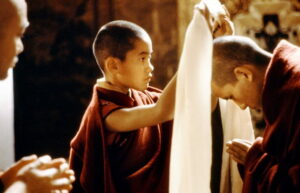Kundun (1997) review
Dir. Martin Scorsese
By: Steve Pulaski
Rating: ★★★
Opening in 1937 Tibet, four years after the death of the 13th Dalai Lama, Kundun shows a group of monks finding a young boy they feel is their reincarnated leader – the one prophesied and spoken about by their late, holy figure. The boy is only two, and once he’s taken with them, he does all the things you expect a two-year-old to do. When faced with a plethora of objects, he selfishly hoards them and keeps them to himself. He requests things at the drop of the hat once he discovers he has servants at his service at all hours of the day and night. He grows up spoiled, and maybe rightfully so, for he is the 14th Dalai Lama.
Martin Scorsese’s story about Tibet’s most controversial leader strangely winds up being one of his most forgotten films. Nearly a full treatment after giving Jesus Christ one of the best, most harrowing depictions, Scorsese and screenwriter Melissa Mathison examine another leader with incredible convictions and an unconventional upbringing. Played by four different actors from infancy to adulthood, the Dalai Lama is shown as a larger-than-life figure called upon in a time when the security of Tibet is uncertain as the Chinese are looking to invade. Caught between the push-pull of remaining nonviolent and defending his land and his people, the Dalai Lama – played by Tenzin Thuthob Tsarong in his only acting credit – looks to meet with his people as well as the irreligious Chairman Mao in order to try and prevent a controversial upheaval and seizing of land.
Scorsese’s interest in Tibet and its leader ostensibly comes from the aforementioned problem at the center of the film, which is Dalai Lama’s aggressive commitment to remaining god-fearing in a godless world. He hears from Chairman Mao about the death of religion and sees things around him – such as modern Western-influenced architecture and his own moccasins – become increasingly contemporary rather than tradition-based. As much as this haunts him, the Dalai Lama must nonetheless give the impression of strength and perseverance even as all seems lost and China’s stranglehold on the small country becomes more suffocating.
Scorsese and Mathison appear to find this mental crux fascinating, and instead of opting for a chronological narrative, opt for one that favors an episodic structure. Moments feel like just that; moments over a grander, larger life, and we’re privileged enough to see the “greatest hits,” so to speak. Working with debatably one of the greatest cinematographers in film history, Roger Deakins gives Kundun the most attractive photography a Scorsese film has ever seen. Separated from the caustic urban decay of Goodfellas and the lush, red-velvet padding found en masse in Casino – Scorsese’s previous film, Kundun feels like a holy book was opened and brought to life before the eyes of a crowded prayer circle or worship room for monks. It has all the hallmarks of a visually arresting movie, able to transport without seeming transparent.
Again adhering to the favoritism of making the Dalai Lama’s life one of many defining moments, one of the most fascinating is a banal one early in the film, where the young leader interrupts his own lengthy meditation amongst a group of monks to watch a rat loudly slurp up water. The rat’s presence and noisy activity disrupts what is otherwise a serene scene, and the boy’s curiosity and attraction to what others might close their eyes to is symbolism that doesn’t get lost in a sometimes disjointed structure that prevents characterization from being overly obvious.
Kundun, which means “presence” in Tibet, is noticeable for also being one of the very few American-made films not to feature a single recognizable, “billboard worthy” actor. Not a single recognizable face is amongst the crowd of Tibetan and Chinese natives, most of whom have sole film credits and are undoubtedly living their lives with Kundun long out of their minds. A feature like this is easy to go unnoticed, but it reminds how organic a film experience can be. As I’ve said before, can you really watch an average gangster movie and believe you’re watching a real criminal operate when the anti-hero is Brad Pitt, who looks like he just got out of the makeup chair that was captured in this week’s tabloid?
The final shot of Kundun is as gorgeous and as vast as anything Deakins or Scorsese have captured in both of their lengthy, legacy-defining film careers. The serenity of this film, in addition to its gorgeous visuals, is one of its biggest assets. It doesn’t feel artificial; too far out of arm’s reach sometimes, yes, with a character that Mathison sometimes admires more-so than understands. But Kundun is an aesthetically graceful movie with themes closely intertwined with Scorsese’s love for troubled leaders working out spiritual and personal identities all while handicapped by holding positions of power.
NOTE: As of this writing, Kundun is available to watch on YouTube, free of charge.
OTHER REVIEWS OF MARTIN SCORSESE FILMS:
My review of The Irishman
My review of Killers of the Flower Moon
Starring: Tenzin Thuthob Tsarong. Directed by: Martin Scorsese.
About Steve Pulaski
Steve Pulaski has been reviewing movies since 2009 for a barrage of different outlets. He graduated North Central College in 2018 and currently works as an on-air radio personality. He also hosts a weekly movie podcast called "Sleepless with Steve," dedicated to film and the film industry, on his YouTube channel. In addition to writing, he's a die-hard Chicago Bears fan and has two cats, appropriately named Siskel and Ebert!


